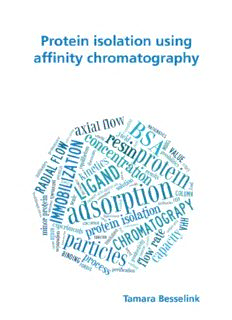
Protein isolation using affinity chromatography PDF
Preview Protein isolation using affinity chromatography
Propositions 1. When comparing chromatographic media or configurations, at least one will perform suboptimal. (this thesis) 2. A chromatographic monolith has advantages over a packed bed of porous particles only when very small or very large molecules are to be adsorbed. (this thesis) 3. More precise measurements do not always produce more precise results. 4. The word ‘science’ suggests a certainty that often does not exist. 5. You only truly understand something if you can explain it to others. 6. On‐line social media often result in asocial behaviour in real‐life. 7. Flexible working hours, especially when working from home, make it harder to balance work and private life. Propositions belonging to the thesis: ‘Protein isolation using affinity chromatography’ Tamara Besselink Wageningen, 7 December 2012 Protein isolation using affinity chromatography Tamara Besselink Thesis committee Promotor Prof. dr. ir. R.M. Boom Professor of Food Process Engineering Wageningen University Co‐promotor Dr. ir. A.E.M. Janssen Assistant professor, Food Process Engineering Group Wageningen University Other members Prof. dr. W.J.H. van Berkel, Wageningen University Dr. ir. P.J.Th. Bussmann, TNO, Zeist Prof. dr. ir. A.B. de Haan, Eindhoven University of Technology Prof. dr. J.D. Mikkelsen, Technical University of Denmark This research was conducted under the auspices of the graduate school VLAG (Advanced studies in Food Technology, Agrobiotechnology, Nutrition and Health Sciences). Protein isolation using affinity chromatography Tamara Besselink Thesis submitted in fulfilment of the requirements for the degree of doctor at Wageningen University by the authority of the Rector Magnificus Prof. dr. M.J. Kropff, in the presence of the Thesis Committee appointed by the Academic Board to be defended in public on Friday 7 December 2012 at 1.30 p.m. in the Aula. Tamara Besselink Protein isolation using affinity chromatography 146 pages. PhD thesis, Wageningen University, Wageningen, NL (2012) With references, with summaries in Dutch and English ISBN 978‐94‐6173‐426‐6 Contents Chapter 1 Introduction 1 Chapter 2 Isolation of bovine serum albumin from whey using affinity 9 chromatography Chapter 3 The influence of pH and temperature on bovine serum albumin – 25 VHH ligand binding Chapter 4 Comparison of activated chromatography resins for protein 49 immobilization Chapter 5 Efficiency of protein‐based ligand immobilization for affinity 67 chromatography Chapter 6 Are axial and radial flow chromatography different? 83 Chapter 7 General Discussion 109 Summary 131 Samenvatting 135 Dankwoord 139 Curriculum Vitae 141 Publications 143 Overview of completed training activities 145 Chapter 1 Introduction 1.1 A short history of chromatography According to IUPAC (International Union of Pure and Applied Chemistry) the official definition of chromatography is “a physical method of separation in which the components to be separated are distributed between two phases, one of which is stationary (stationary phase) while the other (the mobile phase) moves in a definite direction” [1]. Literally, the word chromatography means ‘colour writing’ and dates back to 1906. The Russian botanist Mikhail Tswett (his last name meaning ‘colour’ or ‘flowering’ in Russian) separated colourful plant pigments from each other using a column packed with an adsorbent [2]. Tswett investigated many different adsorbents (stationary phases) and solvents (mobile phases) to find an optimal separation method. It took over thirty years before the value of Tswetts work was recognized [3]. This was mainly due to the work of Nobel Prize winners A.J.P. Martin and R.L.M. Synge who described the chromatography process theoretically. From there gas chromatography and new types of liquid chromatography were developed. For a long time, chromatography was mainly used as an analytical tool using small sample sizes. Later on, the preparative use of chromatography was rediscovered (e.g., [4]), with its main applications in the pharmaceutical industry. The challenges in scale‐up of chromatography processes, the batch‐wise nature of the process, the amount of solvents (buffers) required, and the high costs of target‐specific chromatography adsorbents are the main reasons why chromatography is not more widely used. For pharmaceuticals, purity is crucial and high separation costs can be acceptable in this field. A picture of a contemporary lab‐scale preparative chromatography system is shown in Figure 1.1. 1 Chapter 1 Figure 1.1. Example of a lab scale preparative chromatography setup with an Äkta Purifier (GE Healthcare, Uppsala, Sweden). 1.2 Chromatography adsorbents and ligands Chromatography can be used to separate a mixture into its components. Two phases can be distinguished: the mobile phase, which can be a solvent but also the feed mixture itself, and the stationary phase, the adsorbent. The adsorbent or resin usually consists of spherical particles made of agarose, cellulose, polymethacrylate, silica and many other materials which are packed in a cylindrical column. The particles may be porous or non‐porous. Membranes and monoliths can also be used as a stationary phase [5]. Several methods of separation exist in chromatography. In size‐exclusion chromatography, also known as gel filtration chromatography, components are separated based on size. This method is mainly suitable for analytical purposes and final polishing, because the column cannot be loaded with the mixture to be separated for more than ~5% of the column volume. Another possibility is to adsorb components to the stationary phase. This means that after adsorption, a change in buffer is required to desorb the components from the stationary phase. As an example, charged components can be separated using ion exchange, a method that is frequently applied in the pharmaceutical industry, and for example in the desalting of whey. To remove the adsorbed components, a salt gradient is used. On small scales, it is used in mechanical dish washers to remove multivalent ions from water. The most specific method in chromatography is affinity chromatography. This type of chromatography relies on specific interaction between the target component and a 2
Description: